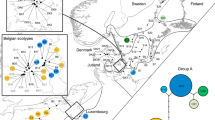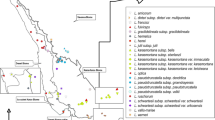Abstract
The genusArgyranthemum (Asteraceae: Anthemideae) comprises 38 taxa and is restricted to the archipelagos of the Canaries, Selvagens, Madeira, and Desertas in the Macaronesian biogeographic region. An electrophoretic study, including 17 enzyme loci and at least one population of each of the described taxa, was carried out. High identity (low distance) values between taxa (mean of 0.893) were obtained despite the old age of the islands, their close proximity to the African continent, and the fact thatArgyranthemum is the most species-rich and variable genus in Macaronesia. These results suggest that the genus is monophyletic and that it has evolved very rapidly in these islands. There is little correspondence between taxonomy and neighbor-joining analysis based on Roger's genetic distances, but in several instances populations from the same islands cluster together despite being from different species or even different sections. It is suggested that repeated genetic bottlenecks associated with the founding of new populations during radiation of the genus resulted in lineage sorting of ancestral allozyme polymorphisms. Because every population has a high average identity with all other populations, lineage sorting could result in populations of different taxa being slightly more similar than populations of the same taxon. Gene flow between different species on the same island could account for some populations clustering by island of origin rather than taxonomic disposition. Average allozyme diversity within populations (0.098) is 50% higher than the mean total diversity for species endemic to oceanic islands.
Similar content being viewed by others
References
Abdel-Monem, A., Watkins, N. D., Gast, P. W., 1971: Potassium-argon ages, volcanic stratigraphy, and geomagnetic polarity history of the Canary Islands: Lanzarote, Fuerteventura, Gran Canaria and La Gomera. — Amer. J. Sci.271: 490–512.
Abdel-Monem, A., Watkins, N. D., Gast, P. W., 1972: Potassium-argon ages, volcanic stratigraphy, and geomagnetic polarity history of the Canary Islands: Tenerife, La Palma, and El Hierro. — Amer. J. Sci.272: 805–825.
Ancochea, E., Fúster, J. M., Ibarrola, E., Cendrero, A., Coello, J., Hernán, F., Cantagrel, J. M., Jamond, C., 1990: Volcanic evolution of the island of Tenerife (Canary Islands) in the light of new K-Ar data. — J. Volcanol. Geotherm. Res.44: 231–249.
Ancochea, E., Hernan, F., Cendrero, A., Cantagrel, J. M., Fúster, J. M., Ibarrola, E., Coello, J., 1994: Constructive and destructive episodes in the building of a young oceanic island, La Palma, Canary Islands, and genesis of the Caldera de Taburiente. — J. Volcanol. Geotherm. Res.60: 243–262.
Ardevol-González, J. F., Borgen, L., Pérez de Paz, P. L., 1993: Checklist of chromosome numbers in Canarian vascular plants. — Sommerfeltia18: 1–59.
Banda, E., Dañobeitia, J. J., Suriñach, E., Ansorge, J., 1981: Features of crustal structure under the Canary Islands. — Earth Planet. Sci. Lett.55: 11–24.
Borgen, L., 1976: Analysis of a hybrid swarm betweenArgyranthemum adauctum andA. filifolium in the Canary Islands. — Norweg. J. Bot.19: 149–170.
Borgen, L., 1980: A new species ofArgyranthemum (Compositae) from the Canary Islands. — Norweg. J. Bot.23: 149–170.
Borgen, L., Bramwell, D., 1976: The endemic flora of the Canary Islands: distribution, relationships and phytogeography. — InKunkel, G., (Ed.): Biogeography and ecology in the Canary Islands, pp. 207–240. — The Hague: Junk.
Brochmann, C., 1984: Hybridization and distribution ofArgyranthemum coronopifolium (Asteraceae — Anthemideae) in the Canary Islands. — Nordic J. Bot.4: 729–736.
Brochmann, C., 1987: Evaluation of some methods for hybrid analysis, exemplified by hybridization inArgyranthemum (Asteraceae). — Nordic J. Bot.7: 609–630.
Cantagrel, J. M., Cendredo, A., Fúster, J. M., Ibarrola, E., Jamond, C., 1984: K-Ar chronology of the volcanic eruptions in the Canarian Archipelago: island of La Gomera. — Bull. Volcanol.47: 597–609.
Carlquist, S., 1965: Island life. A natural history of the islands of the world. — New York: The Natural History Press.
Carracedo, J. C., 1994: The Canary Islands: an example of structural control on the growth of large oceanic island volcanoes. — J. Volcanol. Geotherm. Res.60: 225–241.
Coello, J., Cantagrel, J. M., Hernán, F., Fúster, J. M., Ibarrola, E., Ancochea, E., Casquet, C., Jamond, C., Díaz de Terán, J. R., Cendrero, A., 1992: Evolution of the eastern volcanic ridge of the Canary Islands based on new K-Ar data. — J. Volcanol. Geotherm. Res.53: 251–274.
Crawford, D. J., 1990: Plant molecular systematics. Macromolecular approaches. — New York: Wiley.
Crawford, D. J., Whitkus, R., Stuessy, T. F., 1987: Plant evolution and speciation on oceanic islands. — InUrbanska, K., (Ed.): Differentiation patterns in higher plants, pp. 183–199. — London: Academic Press.
de Joode, D. R., Wendel, J. F., 1992: Genetic diversity and origin of the Hawaiian Islands cotton,Gossypium tomentosum. — Amer. J. Bot.79: 1311–1319.
Francisco-Ortega, J., Jackson, M. T., Catty, J. P., Ford-Lloyd, B. V., 1992: Genetic diversity in theChamaecytisus proliferus complex (Fabaceae: Genisteae) in the Canary Islands in relation to in situ conservation. — Genet. Resources Crop Evol.39: 149–158.
Francisco-Ortega, J., Ellis, R. H., González-Feria, E., Santos-Guerra, A., 1994: Overcoming seed dormancy in ex situ plant germplasm conservation programs; an example in the endemicArgyranthemum (Asteraceae: Anthemideae) from the Canary Islands. — Biodiversity Conserv.3: 341–353.
Francisco-Ortega, J., Crawford, D. J., Santos-Guerra, A., Sa-Fontinha, S., 1995a: Genetic divergence among Mediterranean and Macaronesian genera of the subtribeChrysantheminae (Asteraceae). — Amer. J. Bot.82: 1321–1328.
Francisco-Ortega, J., Jansen, R. K., Crawford, D. J., Santos-Guerra, A., 1995b: Chloroplast DNA evidence for intergeneric relationships of the Macaronesian endemic genusArgyranthemum (Asteraceae). — Syst. Bot.20: 413–422.
Francisco-Ortega, J., Santos-Guerra, A., Mesa-Coello, R., González-Feria, E., Crawford, D. J., 1996a: Genetic resource conservation of the endemic genusArgyranthemum Sch. Bip. (Asteraceae: Anthemideae) in the Macaronesian islands. — Genet. Resources Crop Evol.43: 33–39.
—, 1996b: Chloroplast DNA evidence of colonization, adaptive radiation, and hybridization in the evolution of the Macaronesian flora. — Proc. Natl. Acad. Sci. USA93: 4085–4090.
Fúster, J. M., Hernán, F., Cendero, A., Coello, J., Cantagrel, J. M., Ancochea, E., Ibarrola, E., 1993: Geocronología de la isla de El Hierro (Islas Canarias). — Bol. Soc. Esp. Hist. Nat.88: 1–4.
Galopim de Carvalho, A. M., Brandao, J. M., 1991: Geologia do archipélago da Madeira. — Lisbon: Museu Nacional de História Natural (Mineralogia e Geologia) da Universidade de Lisboa.
Gottlieb, L. D., 1981: Gene number in species ofAsteraceae that have different chromosome number. — Proc. Natl. Acad. Sci. USA78: 3726–3729.
—, 1982: Conservation and duplication of isozymes in plants. — Science216: 373–380.
Hansen, A., Sunding, P., 1993: Flora of Macaronesia. Checklist of vascular plants, 4th edn. — Sommerfeltia17: 1–296.
Helenurm, K., Ganders, F. R., 1985: Adaptive radiation and genetic differentiation in HawaiianBidens. — Evolution39: 753–765.
Hodges, S. A., Arnold, M. L., 1994: Floral and ecological isolation betweenAquilegia formosa andAquilegia pubescens. — Proc. Natl. Acad. Sci. USA91: 2493–2496.
Howard, R. A., 1973: The vegetation of the Antilles. — InGraham, A., (Ed.): Vegetation and vegetational history of northern Latin America, pp. 1–38. — Amsterdam, London, New York: Elsevier.
Humphries, C. J., 1976a: A revision of the Macaronesian genusArgyranthemum Webb exSchultz Bip. (Compositae-Anthemideae). — Bull. Brit. Mus. (Nat. Hist.), Bot.5: 1–140.
—, 1976b: Evolution and endemism inArgyranthemum Webb exSchultz Bip. (Compositae-Anthemideae). — Bot. Macaronés.1: 25–50.
—, 1979: Endemism and evolution in Macaronesia. — InBramwell, D., (Ed.): Plants and islands, pp. 171–199. — London: Academic Press.
Kephart, S. R., 1990: Starch gel electrophoresis of plant isozymes: a comparative analysis of techniques. — Amer. J. Bot.77: 693–712.
Kunkel, G., 1971: Sobre el géneroArgyranthemum en Gran Canaria y sobreChrysanthemum en general. — Cuad. Bot. Canaria12: 41–44.
Lewis, P., 1993: GeneStat-PC 3.3. — Raleigh, North Carolina: Department of Statistics, North Carolina State University.
Lowrey, T., Crawford, D. J., 1985: Allozyme divergence and evolution inTetramolopium (Compositae: Astereae) on the Hawaiian Islands. — Syst. Bot.10: 64–72.
McDougall, I., Schmincke, H. U., 1976–1977: Geochronology of Gran Canaria, Canary Islands: age of shield building volcanism and other magmatic phases. — Bull. Volcanol.40: 57–77.
Mitchell, J. G., Le Bas, M. J., Zielonka, M. J., Furnes, H., 1983: On dating the magmatism of Maio, Cape Verde Islands. — Earth Planet. Sci. Lett.64: 61–76.
Morikawa, T., Leggett, J. M., 1990: Isozyme polymorphism in natural populations ofAvena canariensis from the Canary Islands. — Heredity64: 403–411.
Nei, M., 1972: Genetic distance between populations. — Amer. Naturalist106: 283–293.
—, 1973: Analysis of gene diversity in subdivided populations. — Proc. Natl. Acad. Sci. USA70: 3321–3323.
Pedrola-Monfort, J., Caujapé-Castells, J., 1994: Allozymic and morphological relationships amongAndrocymbium gramineum, A. europaeum, andA. psammophilum (Colchicaceae). — Pl. Syst. Evol.191: 111–126.
Rivas-Martinez, S., 1987: Memoria del mapa de series de vegetación de España. 1:400,000. — Madrid: Instituto para la Conservación de la Naturaleza.
Rogers, J. S., 1972: Measures of genetic similarity and genetic distance. — Studies in Genetics VII. — Univ. Texas Publ.7213: 145–153.
Rohlf, F. J., 1992: NTSYS-pc version 1.70. Numerical taxonomy and multivariate analysis system. — New York: Exeter Software.
Rustan, Ø. H., 1981: Infraspecific variation inArgyranthemum pinnatifidum (Lowe)Lowe. — Bocagiana55: 2–18.
Sahuquillo, E., Lumaret, R., 1995: Variation in the subtropical group ofDactylis glomerata L. — 1. Evidence from allozyme polymorphism. — Biochem. Syst. Ecol.23: 407–418.
Saitou, N., Nei, M., 1987: The neighbor-joining method: a new method for reconstructing phylogenetic trees. — Molec. Biol. Evol.4: 406–425.
Santos-Guerra, A., 1983: Vegetación y flora de La Palma. — Santa Cruz de Tenerife, Canary Islands: Interinsular Canaria.
Sjögren, E., 1972: Vascular plant communities of Madeira. — Bol. Mus. Munic. Funchal26: 45–125.
Sunding, P., 1979: Origins of the Macaronesian flora. — InBramwell, D., (Ed.): Plants and islands, pp. 13–40. — London: Academic Press.
Weeden, N. F., Wendel, J. F., 1989: Genetics of plant isozymes. — InSoltis, D. E., Soltis, P. S., (Eds): Isozymes in plant biology, pp. 46–72. — Portland: Dioscorides Press.
Wendel, J. F., Weeden, N. F., 1989: Visualization and interpretation of plant isozymes. — InSoltis, D. E., Soltis, P. S., (Eds): Isozymes in plant biology, pp. 5–45. — Portland: Dioscorides Press.
—, 1990: Molecular divergence in the Galapagos Islands — Baja California species pair,Gossypium klotzschianum andG. davidsonii (Malvaceae). — Pl. Syst. Evol.171: 99–115.
Witter, M. S., Carr, G. D., 1988: Adaptive radiation and genetic differentiation in the Hawaiian silversword alliance (Compositae: Madiinae). — Evolution42: 1278–1287.
Author information
Authors and Affiliations
Rights and permissions
About this article
Cite this article
Francisco-Ortega, J., Crawford, D.J., Santos-Guerra, A. et al. Isozyme differentiation in the endemic genusArgyranthemum (Asteraceae: Anthemideae) in the Macaronesian Islands. Pl Syst Evol 202, 137–152 (1996). https://doi.org/10.1007/BF00983379
Received:
Revised:
Accepted:
Issue Date:
DOI: https://doi.org/10.1007/BF00983379




